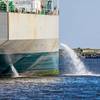For more than 30 years, Markey Machinery has worked with the LNG and marine transportation Industries with the goal of developing winches designed to work under the most challenging conditions. The effort includes extensive design shop testing and actual commercial work, a combination that has ultimately produced an understanding of the operational issues facing terminal and tug operators.
The many milestones in the development of Markey’s Asymmetrical Render/Recover (ARR) – technology by which hawser winches are able to maintain mean line pulls up to the bollard pull of the tug – came over a period of time that spans 25 years. The initial 20+ years of hawser winch design and Render/Recover development followed a traditional design path, influenced, in part, by market pressures. It was primarily due to the application of Class I and Class II winch designs on vessels operating in quiet-water locations that allowed this approach to be successful.
As the transportation of high-risk payloads encountered increasingly rough waters, it became routine to escort these ships for long distances during their journey to the terminal. While Class I and Class II winches continue to operate in areas that are not exposed, Class III ARR winches address the need to deal with harsh environmental conditions, while maintaining control of the line at all times. And, that’s where Markey comes in.
Winch Development 101
The basic function of any hawser winch is to either pull in, or pay out a tether. Hawser winch tethers are typically composed of either steel wire rope, or fiber rope of natural or synthetic construction. The winch has a brake, which holds the drum, and any load attached to the end of the tether. Historically hawser winches use band brakes, which are by design an “on-off” brake. Any attempt to “slip” these brakes will result in sudden loosening or binding. The operator manually controls speed, direction of rotation, and brake set. Many of the Class 1 winches delivered by Markey over the past 100+ years fit this description.
While Class I winches work well in steady conditions of calm waters with light winds and currents, they are not suited for operation in highly dynamic wave conditions. A common application for a Class I winch would be harbor docking service in an interior waterway or basin. But, Class I winches pose operational challenges in dynamic situations, particularly in escort operations requiring frequent repositioning of the tug relative to the assisted vessel.
While skilled operators have over time developed ways to achieve an “active drum” on a Class I winch, at the same time, their ability to focus on maneuvering was limited, since considerable attention was required for winch operation. John Davis, Markey Sales Engineer explained, “Anecdotally, an argument can always be made that machines employing automatic controls are always safer for the simple reason that the processor is ever alert, never tires, and consistently responds in near real time according to a set of established operational criteria.”
The Advent of Synthetic Rope
The introduction of synthetic ropes in the 1980s came with many advantages. Easier to handle, lighter, and nominally safer than wire rope, synthetic ropes also floated. Maintaining line tension suddenly became an important requirement as the danger of fouling the tug’s propellers with a slack line became apparent. This led to the creation of technology to automatically render (pay out) and recover (haul in) line to maintain that tension while preventing ‘slack line’ conditions. The term ‘Render/Recover’ was soon thereafter coined, and Markey was at the heart of its development. As Markey looked into ways to integrate true Render/Recover functionality into hawser winches, they also knew that this new winch would need specific features, which would:
- Provide full range controllable line pull in either direction (inhaul and payout).
- Allow for “instant” inhaul at full line pull and speed.
- Allow controllable relief path for hard rendering at up to three times flow rate.
- Simultaneously dump flow from the hydraulic pump.
- Allow instant freewheel at high speeds using features of the motor.
At the same time, rising energy costs, operational efficiency concerns, hydraulic noise and heat generation and customer worries about hydraulic oil spills spurred Markey to develop ‘vector duty’ electric motors coupled with AC variable frequency drives (VFD’s) to power the next generation of hawser winches. In 2001, Markey delivered to Moran Towing Corporation the first version of an electrically driven hawser winch offering Render/Recover technology.
The ‘Diane Moran’ was a 5100 HP ASD Tug capable of 65 Tons bollard pull. The winch employed a 50 HP variable frequency drive controlling a vector-duty motor. Built for operation above deck, the winch allowed for winch drum freewheeling, for faster payout. The Render/Recover feature allowed the winch to automatically pay out (render) or haul in (recover) line to maintain a pre-set line tension. This allowed the winch to function automatically to maintain tension, thus keeping the line clear of the water during tug repositioning, while reducing subsequent snap loads that could part the line.
Next up for Markey was the creation of a winch that would allow operating in waves that caused significant tug movement. Maintaining a line tension setting regardless of such movement led to the development of the Markey ARR (Asymmetric Render/Recover) system. The Markey ARR requires more horsepower, which favored the electric solution. That’s because the hydrodynamic performance of tugs in exposed sea states dictates that the amount of winch power required to mitigate wave motion does not have to be equal during line rendering and recovery. Utilizing a mathematical simulation with the winch dissipating more power in rendering than during recovery, it could achieve successful Render/Recover operation, in exposed conditions, thus allowing minimizing the motor horsepower.
A 250 HP unit went into operation in 2002 and two 100 HP units in 2006, which all performed well. Four more units went recently in operation, two 100 HP and two 200 hp. All of the foregoing units performed well in environments where waves of up to 2 meters were present. Eventually, Markey was approached about equipment to accommodate 3 meter waves, in narrow waters, at the Energia Costa Azul LNG terminal off the Mexican West Coast. Four tugs, jointly owned and operated by Moran and its partner Grupo Boluda Maritime Corporation of Spain are based there to provide escort to incoming LNG carriers.
Markey asked Eagle Harbor Engineering to create a mathematical model of operating conditions that this application might pose. This model constituted the early beginnings of Markey’s winch simulation technology. Offshore Research Ltd at the Ocean Engineering Centre in Vancouver, British Columbia, Canada subsequently conducted modeling of winch and vessel operation. The test parameters focused on a “worst case” scenario.
Each of the tugs is equipped with winches that have double “waterfall” drums, with 200 meters of 80 mm diameter high-performance synthetic rope on each drum. They are bow mounted on the compact, high powered twin screw Z-drive tugs, used to escort and berth LNG tankers in up to 3 meter swells. A 760 HP electric, AC variable frequency drive with closed loop tension control powers each. The winch can operate in dynamic seas up to 3 meters at full bollard pull. It utilizes a two-speed gear drive and dynamic water-cooled brakes below deck.
Testing Under Actual Conditions
Prior to beginning operations, crews were prepared through an extensive operational training program. Because the ARR system offered an entirely new concept in tug operation, the training covered the proper use of the Render/Recover system, including how best to set the tension and sensitivity adjustments. Each winch was subjected to a thorough systematic test program after installation on the tugs.
Although data collected during operation at or near full capacity is more desirable, verification of predicted model performance is possible even during routine outings. The results of a routine escort of an LNG tanker in August of 2010 provided an excellent example. In this case, the escort occurred during a period of 1.6 meter wave heights, the highest being 2 meters, with wind gusts of 9 to 13 knots headed NNW.
Winch instrumentation was collected and saved operational data, so that it would be available for later download via a cell network for evaluation. This was also the method used for subsequent troubleshooting. Service personnel in Seattle were able to download the system’s alarm history remotely, which greatly expedited the resolution of incorrect drive settings.
Eventually, Markey engineers were aboard to witness the berthing of a large vessel in approximately 2.5 meters swell, with a 10-14 sec period, and light winds of 4-6 knots. The operation seemed surprisingly effortless, and the consensus afterwards was that this tug/winch combination, with four tugs available, was likely able to berth tankers in swell well over 3 meters. Since then, a later berthing in swells exceeding 3 meters confirmed that consensus.
Matching Data, Real Performance
According to Markey, matching winch performance to tug performance and the demands of a particular terminal is now achievable using the tools developed over the last several years. And, it turns out that American manufacturing, in this case, is quite competitive globally. A study done by Robert Allan Ltd evaluating components for a multi-tug contract concluded that “The vast majority of operators agree that the electric-driven Markey Render-Recover winch is the best winch technology on the market today. There is also a general perception that Markey winches are significantly more expensive than others on the market, however when one compares winches from various qualified sources according to a common detailed specification, then Markey proves to be extremely competitive on a world-scale.”
Today’s design methodology now includes mathematical modeling, to determine the most cost-effective and efficient solution to a specific terminals performance requirements. This methodology allows designers to predict and match winch performance to the environmental requirements prior to build and manufacture. Markey Machinery President Blaine Dempke added, “We validated the accuracy of the modeling calculations through testing, in actual operation and demonstrated an accurate correlation between the two.”
Providing the exclamation point on that sort of claim, one of the four tugs, together with a conventional tug, towed a disabled cruise ship from its position off the Mexican Coast near Ensenada, to San Diego in November 2010. Some stakeholders said it could not be done. Dempke remarked, “We do not know whether it set a record for longest soft-line emergency tow, but it was a completely uneventful routine operation.” Today, Markey’s Asymmetrical Render/Recover (ARR) technology continues to provide operators with never before achieved margins of safety and performance. Already tried and tested under the toughest conditions, Markey’s ARR is clearly ready for what comes next.
(As published in the September 2017 edition of
Marine News)










